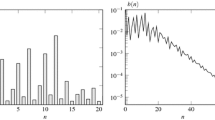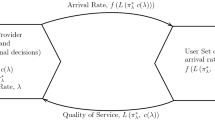Abstract
We discuss a model for general single class queueing networks which allows discrete and fluid customers and lives on the time interval R. The input for the model are the cumulative service time developments, the cumulative external arrivals and the cumulative routing decisions of the queues. A path space fixed point equation characterizes the corresponding behavior of the network. Monotonicity properties imply the existence of a largest and a smallest solution. Despite the possible non-uniqueness of solutions the sets of solutions have several nice properties. The set valued solution map is partially upper semicontinuous with respect to a quasi-linearly discounted uniform metric on the input paths space. In addition to this main result, we investigate convergence of approximate solutions, measurability, monotonicity and stationarity. We give typical examples for situations where solutions are non-unique and unique.
Similar content being viewed by others
References
J.-P. Aubin and H. Frankowska, Set-Valued Analysis (Birkhäuser, Basel, 1990).
F. Baccelli and S. Foss, Ergodicity of Jackson-type queueing networks, Queueing Systems 17 (1994) 5–72.
F. Baccelli, S. Foss and J. Mairesse, Stationary ergodic Jackson networks: Results and counterexamples, in: Stochastic Networks: Theory and Applications, eds. F.P. Kelly, S. Zachary and I. Ziedins, Royal Statistical Society Lecture Note Series, Vol. 4 (Oxford Science, Oxford, 1996) pp. 281–307.
P. Billingsley, Convergence of Probability Measures (Wiley, New York, 1968).
K.C. Border, Fixed Point Theorems with Applications to Economics and Game Theory (Cambridge Univ. Press, Cambridge, 1985).
M. Bramson, Instability of FIFO queueing networks, Ann. Appl. Probab. 4(2) (1994) 414–431.
J.W. Cohen, The Single Server Queue, Applied Mathematics and Mechanics, Vol. 8, revised ed. (North-Holland, Amsterdam, 1982).
R.W. Cottle, J.-S. Pang and R.E. Stone, The Linear Complementarity Problem (Academic Press, New York, 1992).
J.G. Dai, On positive Harris recurrence of multiclass queueing networks: A unified approach via fluid limit models, Ann. Appl. Probab. 5(1) (1995) 49–77.
J. Dai, Stability of open multiclass queueing networks via fluid models, in: Stochastic Networks, eds. F.P. Kelly and R.J. Williams (Springer, Berlin, 1995) pp. 71–90.
J.M. Harrison, Brownian models of queueing networks with heterogeneous customer populations, in: Proc. of a Workshop on Stochastic Differential Systems, Stochastic Control Theory, and Applications, eds. W. Fleming and P.-L. Lions, IMA, 9–19 June 1986 (Springer, Berlin, 1988) pp. 147–186.
J.M. Harrison and V. Nguyen, Brownian models of multiclass queueing networks: Current status and open problems, Queueing Systems 13 (1993) 5–40.
R.M. Loynes, The stability of a queue with non-independent inter-arrials and service times, Math. Proc. Cambridge Philos. Soc. 58 (1962) 497–520.
K. Majewski, Large deviations of feedforward queueing networks, Ph.D. thesis, Ludwig-Maximilians-Universität München (May 1996).
K. Majewski, Heavy traffic approximations of large deviations of feedforward queueing networks, Queueing Systems 28(1–3) (1998) 125–155.
K. Majewski, Large deviations of single class queueing networks and their calculation (September 2000), submitted.
K. Majewski, Path-wise heavy traffic convergence of single class queueing networks and consequences (August 2000), submitted.
N. O'Connell, Stronger topologies for sample path large deviations in Euclidean space, Technical Report HPL-BRIMS-96-005, BRIMS, Hewlett-Packard, Bristol (1996).
D. Pollard, Convergence of Stochastic Processes (Springer, New York, 1984).
S. Ramasubramanian, A subsidy-surplus model and the Skorokhod problem in an orthant, submitted to Math. Oper. Res. (1999).
R. Serfozo, Introduction to Stochastic Networks, Applications of Mathematics, Vol. 44 (Springer, New York, 1999).
W. Whitt, Some useful functions for functional limit theorems, Math. Oper. Res. 5(1) (1980) 67–85.
Author information
Authors and Affiliations
Rights and permissions
About this article
Cite this article
Majewski, K. Single Class Queueing Networks with Discrete and Fluid Customers on the Time Interval R. Queueing Systems 36, 405–435 (2000). https://doi.org/10.1023/A:1011093504603
Issue Date:
DOI: https://doi.org/10.1023/A:1011093504603




